
The Ral color chart classifies colors by a system of numbers and letters. It is important to note that the Ral color chart is an independent system not affiliated to any company or brand. For example, using Ral numbers allow for nearly exact matches of colors across the different paint brands. However, because Ral is a propriety system, it becomes difficult to translate Ral colors to other systems exactly. The following steps show how the Ral color chart can be used.
1. First of all, you have to ensure that the lighting for your color matching comes as close to accurate as possible. For example, if you are matching wall paint, it is important to try to perform the tests in the actual room using both the light in the room and the natural light.
2. Let the Ral color chart be held together at the same angle as the original application. This will help to prevent reflection or shadows from distorting the color.
3. Sort through the color chart until you have visually identified the closest possible match.
4. Identify the Ral number for the identified match and use as appropriate.
1. When converting Ral colors to RGB, it is important to Ral to RGB conversion website that has every Ral color listed and their corresponding RGB numbers.
2. Use the Ral color chart to communicate to the company that prints in RGB what colors you like especially if you have designed in Ral colors but your printer only accepts RGB.
3. It is important to note that Ral issues registers for each of the colors it defines. Therefore, note that Ral does not in any way use color tolerances to identify which applications are true Ral colors.